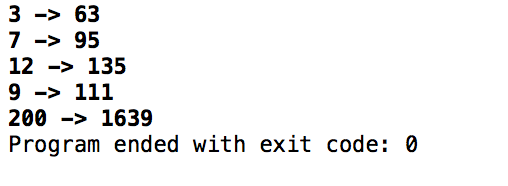今天遇到这样一个问题,我现在有一个整数数组,如:
var numbers = [3, 7, 12, 9, 200]
现需要对其中的每一个数字都执行一系列相同的加减乘除操作,如对每一个数字都加5乘8再减去1,但是这样的操作在编译时并不确定,需要在运行时由用户指定;
一看到这个题目,当然就想到了用设计模式中的命令模式来实现;
于是先写了这样的一个类:
class Calculator {
private(set) var total = 0 required init(value: Int){ total = value } func add(amount: Int) { total += amount } func substract(amount: Int) { total -= amount } func multiply(amount: Int) { total = total * amount } func divide(amount: Int) { total = total / amount } }
这个类用于实现对某个数执行不同的操作。
下一步中我创建了一个Command类,用于记录需要执行的操作:
struct Command { typealias OperationType = (Calculator -> Int -> Void) let operation: OperationType let amount: Int init(operation: OperationType, amount: Int) { self.operation = operation self.amount = amount } func execute(calculator: Calculator) { operation(calculator)(amount) } }
在该类中我定义了一个名为OperationType的类型别名,从定义中可以看出,OperationType类型的实例是一个Closure,该Closure接受一个Calculator类型的实例,并返回一个类型为Int -> Void的Closure(此Closure的类型就是Calculator中每个方法的类型);
amount为执行那个操作的参数值;
待一切完毕后,由用户来指定要执行的命令,如将数组numbers中的每一个值加5乘8再减去1,则可以这样实现:
var commands = [Command]() commands.append(Command(operation: Calculator.add, amount: 5)) commands.append(Command(operation: Calculator.multiply, amount: 8)) commands.append(Command(operation: Calculator.substract, amount: 1))
这样做并没有达到Command设计模式想要达到的目的,及实现命令的发出者与命令的执行者之间的脱耦;于是我加入了一个新的enum类型:
enum OperationType { case Add(Int) case Substract(Int) case Multiply(Int) case Divide(Int) }
这个enum类型中的每一个成员都自带一个关联值,及要执行操作的参数,于是Command类型可以改变为:
struct Command { let operationType: OperationType init(operationType: OperationType) { self.operationType = operationType } func execute(calculator: Calculator) { switch self.operationType { case .Add(let value): calculator.add(value) case .Substract(let value): calculator.substract(value) case .Multiply(let value): calculator.multiply(value) case .Divide(let value): calculator.divide(value) } } }
重新创建Commands数组:
var commands = [Command]() commands.append(Command(operationType: .Add(5))) commands.append(Command(operationType: .Multiply(8))) commands.append(Command(operationType: .Substract(1)))
OK,执行所有命令:
for number in numbers { var calculator = Calculator(value: number) for command in commands { command.execute(calculator) } println("(number) -> (calculator.total)") }
这里是结果:
